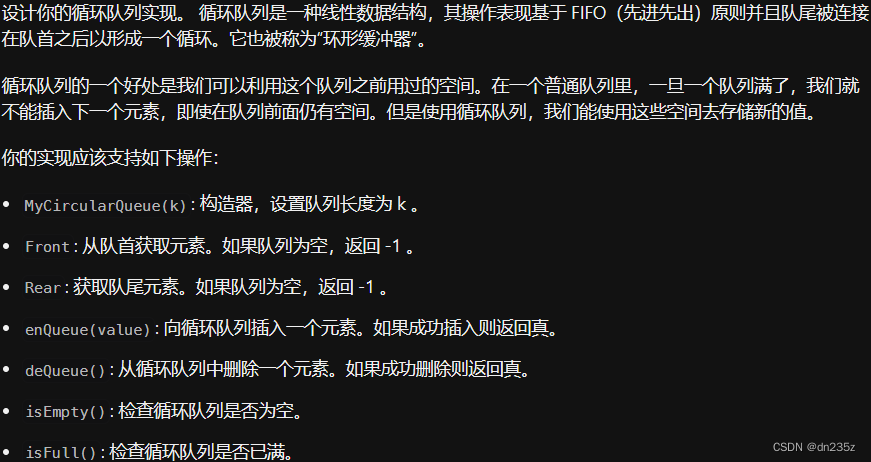队列(8.6)
目录
2.队列
2.1队列的概念及结构
2.2队列的实现
2.2.1初始化队列
2.2.2队尾入队列
2.2.3队头出队列
2.2.4获取队列头部元素
2.2.5 销毁队列
3.栈和队列面试题
225. 用队列实现栈 - 力扣(LeetCode)
232. 用栈实现队列 - 力扣(LeetCode)
编辑
622. 设计循环队列 - 力扣(LeetCode)
编辑
2.队列
2.1队列的概念及结构

将队列运用于抽号机能够计算出排队需要的等待的时间,需要等待前面的人数等信息,也能实现叫号(取队头)操作,能够实现绝对的公平,不存在插队现象。
2.2队列的实现

2.2.1初始化队列
// 初始化队列
void QueueInit(Que* pq)
{
assert(pq);
pq->head = pq->tail = NULL;
pq->size = 0;
}2.2.2队尾入队列
// 队尾入队列
void QueuePush(Que* pq, QDataType x)
{
assert(pq);
//开辟新节点
QNode* newnode = (QNode*)malloc(sizeof(QNode));
if (newnode == NULL)
{
perror("malloc");
exit(-1);
}
//初始化新节点
newnode->data = x;
newnode->next = NULL;
//判断队列是否为空
if (pq->tail == NULL)
{
pq->head = pq->tail = newnode;
}
//不为空尾插
else
{
pq->tail->next = newnode;
pq->tail = newnode;
}
}2.2.3队头出队列

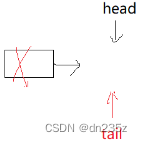
// 队头出队列
void QueuePop(Que* pq)
{
assert(pq);
//列表不能为空
assert(!QueueEmpty(pq));
//如果列表只剩一个成员
if (pq->head->next == NULL)
{
free(pq->head);
pq->head = pq->tail = NULL;
}
//正常头删
else
{
QNode* next = pq->head->next;
free(pq->head);
pq->head = next;
}
pq->size--;
}2.2.4获取队列头部元素
// 获取队列头部元素
QDataType QueueFront(Que* pq)
{
assert(pq);
//检查列表不为空
assert(!QueueEmpty(pq));
return pq->head->data;
}
// 检测队列是否为空,如果为空返回非零结果,如果非空返回0
int QueueEmpty(Que* pq)
{
assert(pq);
//列表为空返回1,不为空返回0
return pq->head == NULL;
}2.2.5 销毁队列
// 销毁队列
void QueueDestroy(Que* pq)
{
assert(pq);
QNode* cur = pq->head;
while (cur)
{
QNode* next = cur->next;
free(cur);
cur = next;
}
pq->head = pq->tail = NULL;
pq->size = 0;
}2.2.6 探空
// 检测队列是否为空,如果为空返回非零结果,如果非空返回0
int QueueEmpty(Que* pq)
{
assert(pq);
//列表为空返回1,不为空返回0
return pq->head == NULL;
}3.栈和队列面试题
225. 用队列实现栈 - 力扣(LeetCode)

分析:创建两个队列入队列:入不为空的队列出队列:出不为空的前n-1个元素,插入到空队列,删除剩余元素


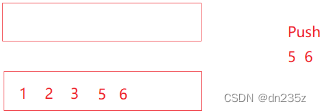

typedef int QDataType;
typedef struct QueueNode
{
QDataType data;
struct QueueNode* next;
}QNode;
typedef struct Que
{
QNode* head;
QNode* tail;
int size;
}Que;
// 初始化队列
void QueueInit(Que* pq);
// 队尾入队列
void QueuePush(Que* pq, QDataType x);
// 队头出队列
void QueuePop(Que* pq);
// 获取队列头部元素
QDataType QueueFront(Que* pq);
// 获取队列队尾元素
QDataType QueueBack(Que* pq);
// 检测队列是否为空,如果为空返回非零结果,如果非空返回0
int QueueEmpty(Que* pq);
// 销毁队列
void QueueDestroy(Que* pq);
//队列节点数
int QueueSize(Que* pq);
// 初始化队列
void QueueInit(Que* pq)
{
assert(pq);
pq->head = pq->tail = NULL;
pq->size = 0;
}
// 队尾入队列
void QueuePush(Que* pq, QDataType x)
{
assert(pq);
//开辟新节点
QNode* newnode = (QNode*)malloc(sizeof(QNode));
if (newnode == NULL)
{
perror("malloc");
exit(-1);
}
//初始化新节点
newnode->data = x;
newnode->next = NULL;
//判断队列是否为空
if (pq->tail == NULL)
{
pq->head = pq->tail = newnode;
pq->size++;
}
//不为空尾插
else
{
pq->tail->next = newnode;
pq->tail = newnode;
pq->size++;
}
}
// 队头出队列
void QueuePop(Que* pq)
{
assert(pq);
//列表不能为空
assert(!QueueEmpty(pq));
//如果列表只剩一个成员
if (pq->head->next == NULL)
{
free(pq->head);
pq->head = pq->tail = NULL;
}
//正常头删
else
{
QNode* next = pq->head->next;
free(pq->head);
pq->head = next;
}
pq->size--;
}
// 获取队列头部元素
QDataType QueueFront(Que* pq)
{
assert(pq);
//检查列表不为空
assert(!QueueEmpty(pq));
return pq->head->data;
}
// 获取队尾元素
QDataType QueueBack(Que* pq)
{
assert(pq);
//检查列表不为空
assert(!QueueEmpty(pq));
return pq->tail->data;
}
// 检测队列是否为空,如果为空返回非零结果,如果非空返回0
int QueueEmpty(Que* pq)
{
assert(pq);
//列表为空返回1,不为空返回0
return pq->head == NULL;
}
// 销毁队列
void QueueDestroy(Que* pq)
{
assert(pq);
QNode* cur = pq->head;
while (cur)
{
QNode* next = cur->next;
free(cur);
cur = next;
}
pq->head = pq->tail = NULL;
pq->size = 0;
}
//队列节点数
int QueueSize(Que* pq)
{
assert(pq);
return pq->size;
}
//定义列表的结构体
typedef struct {
Que q1;
Que q2;
} MyStack;
//列表初始化
MyStack* myStackCreate() {
//不能直接初始化,临时变量,出函数销毁,需要开辟空间
MyStack* pst=(MyStack*)malloc(sizeof(MyStack));
//参数为队列的指针
QueueInit(&pst->q1);
QueueInit(&pst->q2);
return pst;
}
void myStackPush(MyStack* obj, int x) {
//谁不为空push到谁
if(!QueueEmpty(&obj->q1))
{
QueuePush(&obj->q1,x);
}
else
{
QueuePush(&obj->q2,x);
}
}
//出栈
int myStackPop(MyStack* obj) {
//随便假设一个为空队列,一个为非空
Que* empty=&obj->q1;
Que* nonempty=&obj->q2;
//如果假设错误,就交换
if(!QueueEmpty(&obj->q1))
{
nonempty=&obj->q1;
empty=&obj->q2;
}
//将非空栈出到剩尾元素为止
while(QueueSize(nonempty)>1)
{
//非空栈入到空栈
QueuePush(empty,QueueFront(nonempty));
//入一个出一个
QueuePop(nonempty);
}
//保存尾元素
int top=QueueFront(nonempty);
//出掉尾元素
QueuePop(nonempty);
return top;
}
//取栈顶
int myStackTop(MyStack* obj) {
//谁不为空取谁的队尾
if(!QueueEmpty(&obj->q1))
{
return QueueBack(&obj->q1);
}
else
{
return QueueBack(&obj->q2);
}
}
//探空
bool myStackEmpty(MyStack* obj) {
//两个列表都空才为空
return QueueEmpty(&obj->q1)&&QueueEmpty(&obj->q2);
}
void myStackFree(MyStack* obj)
{
//结构体指针下创建了两个列表,需要先释放列表
QueueDestroy(&obj->q1);
QueueDestroy(&obj->q2);
free(obj);
}
/**
* Your MyStack struct will be instantiated and called as such:
* MyStack* obj = myStackCreate();
* myStackPush(obj, x);
* int param_2 = myStackPop(obj);
* int param_3 = myStackTop(obj);
* bool param_4 = myStackEmpty(obj);
* myStackFree(obj);
*/232. 用栈实现队列 - 力扣(LeetCode)
栈的特性是先后进先出,队列的特性是先进先出;若想用栈实现先进先出,就需要另创建一个栈,将原栈中的数据倒过去就能够轻松实现。
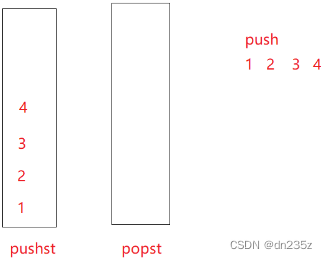
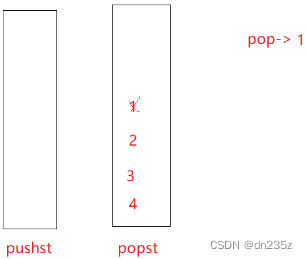
原栈中的数据倒过去之后,此时插入数据,直接插入到原栈中,用原栈专门用来接收数据,如果再出栈,用一个栈专门出栈,当专门出栈的栈出空之后,再从原栈倒数据过来;而不用每次出栈都把数据倒出去又倒回来,很麻烦。
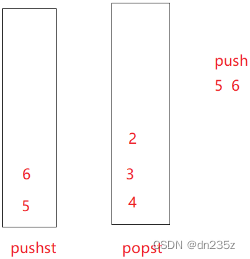
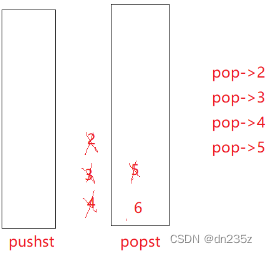
typedef int STDataType;
//支持动态增长的栈
typedef struct Stack
{
STDataType* a;
int top;//栈顶
int capacity;//容量
}ST;
// 初始化栈
void STInit(ST* ps);
// 入栈
void STPush(ST* ps, STDataType x);
// 出栈
void STPop(ST* ps);
// 获取栈顶元素
STDataType STTop(ST* ps);
// 获取栈中有效元素个数
int STSize(ST* ps);
// 检测栈是否为空,如果为空返回非零结果,如果不为空返回0
bool STEmpty(ST* ps);
// 销毁栈
void STDestroy(ST* ps);
void STInit(ST* ps)
{
assert(ps);
ps->a = NULL;
ps->capacity = 0;
ps->top = 0;
}
void STDestroy(ST* ps)
{
assert(ps);
free(ps->a);
ps->a = NULL;
ps->top = ps->capacity = 0;
}
void STPush(ST* ps, STDataType x)
{
assert(ps);
// 11:40
if (ps->top == ps->capacity)
{
int newCapacity = ps->capacity == 0 ? 4 : ps->capacity * 2;
STDataType* tmp = (STDataType*)realloc(ps->a, sizeof(STDataType) * newCapacity);
if (tmp == NULL)
{
perror("realloc fail");
exit(-1);
}
ps->a = tmp;
ps->capacity = newCapacity;
}
ps->a[ps->top] = x;
ps->top++;
}
void STPop(ST* ps)
{
assert(ps);
//
assert(ps->top > 0);
--ps->top;
}
STDataType STTop(ST* ps)
{
assert(ps);
//
assert(ps->top > 0);
return ps->a[ps->top - 1];
}
int STSize(ST* ps)
{
assert(ps);
return ps->top;
}
bool STEmpty(ST* ps)
{
assert(ps);
return ps->top == 0;
}
//定义两个栈类型
typedef struct {
ST pushst;
ST popst;
} MyQueue;
//开辟并初始化结构体变量
MyQueue* myQueueCreate() {
MyQueue* obj=(MyQueue*)malloc(sizeof(MyQueue));
STInit(&obj->pushst);
STInit(&obj->popst);
return obj;
}
void myQueuePush(MyQueue* obj, int x) {
//始终往push栈上面push
STPush(&obj->pushst,x);
}
//出队列
int myQueuePop(MyQueue* obj) {
int front=myQueuePeek(obj);
//与peek唯一不同之处就是取得队头后删掉
STPop(&obj->popst);
return front;
}
//取队头数据
int myQueuePeek(MyQueue* obj) {
if(STEmpty(&obj->popst))
{
//pop为空,从push倒数据
while(!STEmpty(&obj->pushst))
{
//pop入一个
STPush(&obj->popst,STTop(&obj->pushst));
//push出一个
STPop(&obj->pushst);
}
}
//不为空,直出
return STTop(&obj->popst);
}
bool myQueueEmpty(MyQueue* obj) {
//两个栈都为空才为空
return STEmpty(&obj->pushst)&&STEmpty(&obj->popst);
}
void myQueueFree(MyQueue* obj) {
STDestroy(&obj->pushst);
STDestroy(&obj->popst);
free(obj);
}
/**
* Your MyQueue struct will be instantiated and called as such:
* MyQueue* obj = myQueueCreate();
* myQueuePush(obj, x);
* int param_2 = myQueuePop(obj);
* int param_3 = myQueuePeek(obj);
* bool param_4 = myQueueEmpty(obj);
* myQueueFree(obj);
*/622. 设计循环队列 - 力扣(LeetCode)
我们用数组来实现,给数组多开一个 rear 空间(不存数据)用来解决探空和探满的问题

front 为列表头节点的下标,rear 为为尾节点的下一个节点的下标;front 和rear 初始值为0,push 一次 rear ++一次,由于列表是定长的,因此当push 了k个数据时,列表就放满了,不能再入数据。放满的标志为此时列表的实际长度(包括 rear节点)对理论长度 k+1 取余的结果等于 front 。

pop操作,我们直接让 front ++,遵循先进先出的原则。

push 操作,push 一次,rear 向后移动一次,直到 rear 的下一个为 front ,则代表放满,标志依然为(rear+1)%(k+1)=front ,当rear<k,就等于 rear +1= front。
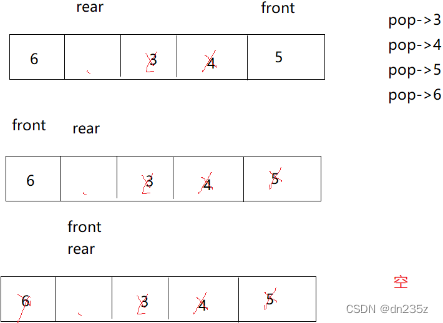
此时再 pop 到 front 处于数组末尾,继续 pop,front 就转到数组开头,当 rear 和 front 重合且为空时,数组就为空。
//定义队列
typedef struct {
//数组
int *a;
//头
int front;
//尾
int rear;
//数组长度(不包含rear)
int k;
} MyCircularQueue;
//初始化队列
MyCircularQueue* myCircularQueueCreate(int k) {
//为队列开空间
MyCircularQueue* obj=(MyCircularQueue*)malloc(sizeof(MyCircularQueue));
//为数组开空间,多开一个rear用于探空(满)
obj->a=(int*)malloc(sizeof(int)*(k+1));
obj->front=obj->rear=0;
obj->k=k;
return obj;
}
//探空(非0为空,0为非空)
bool myCircularQueueIsEmpty(MyCircularQueue* obj) {
//front和rear相等就是空
return obj->front==obj->rear;
}
//探满(非0为满,0为未满)
bool myCircularQueueIsFull(MyCircularQueue* obj) {
//rear的下一个为front为满;rear在队尾,front在对头为满。
return (obj->rear+1)%(obj->k+1)==obj->front;
}
//插入
bool myCircularQueueEnQueue(MyCircularQueue* obj, int value) {
//先探满
if(myCircularQueueIsFull(obj))
{
return false;
}
//正常情况下往rear位置放数据,放完后移
obj->a[obj->rear]=value;
obj->rear++;
//如果rear走到队尾之后(++之后等于k),那么++之后应该挪到队头(归0,因此取模)
//取模操作在走过队尾之前无效
obj->rear%=(obj->k+1);
return true;
}
//删除
bool myCircularQueueDeQueue(MyCircularQueue* obj) {
//先探空
if(myCircularQueueIsEmpty(obj))
{
return false;
}
//正常情况下front后移
obj->front++;
//如果front走到队尾之后(++之后等于k),那么++之后应该挪到队头(归0,因此取模)
obj->front%=(obj->k+1);
return true;
}
//取头
int myCircularQueueFront(MyCircularQueue* obj) {
//探空
if(myCircularQueueIsEmpty(obj))
{
return -1;
}
else
{
return obj->a[obj->front];
}
}
//取尾(取rear的上一个节点)
int myCircularQueueRear(MyCircularQueue* obj) {
//探空
if(myCircularQueueIsEmpty(obj))
{
return -1;
}
else
{
//+k并对k+1取余,当rear在队头,上一个节点就在队尾
//不在队头时取余结果刚好为上一个节点
return obj->a[(obj->rear+obj->k)%(obj->k+1)];
}
}
void myCircularQueueFree(MyCircularQueue* obj) {
free(obj->a);
free(obj);
}
/**
* Your MyCircularQueue struct will be instantiated and called as such:
* MyCircularQueue* obj = myCircularQueueCreate(k);
* bool param_1 = myCircularQueueEnQueue(obj, value);
* bool param_2 = myCircularQueueDeQueue(obj);
* int param_3 = myCircularQueueFront(obj);
* int param_4 = myCircularQueueRear(obj);
* bool param_5 = myCircularQueueIsEmpty(obj);
* bool param_6 = myCircularQueueIsFull(obj);
* myCircularQueueFree(obj);
*/

